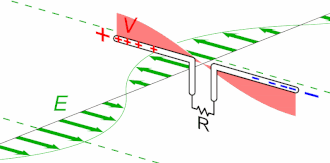Antenna (radio)



File:Antenna Theory Propagation.webm



== Antenna (radio) ==
An antenna (or aerial) is an essential component of radio communication systems. It is a transducer that converts radio frequency (RF) fields into alternating current (AC) or vice versa. Antennas are used in systems such as radio broadcasting, television broadcasting, two-way radio, communications receivers, radar, cellular telephones, and satellite communications.
History[edit]
The development of the antenna can be traced back to the late 19th century with the pioneering work of Heinrich Hertz and Guglielmo Marconi. Hertz demonstrated the existence of electromagnetic waves, while Marconi developed the first practical wireless telegraphy system.
Types of Antennas[edit]
There are various types of antennas, each designed for specific applications and frequency ranges:
- Dipole antenna: One of the simplest and most widely used antennas, consisting of two conductive elements.
- Monopole antenna: Similar to a dipole but with a single element, often mounted over a ground plane.
- Loop antenna: Consists of a loop (or loops) of wire, often used for direction finding.
- Yagi-Uda antenna: A directional antenna consisting of multiple parallel elements in a line, commonly used for television reception.
- Parabolic antenna: Uses a parabolic reflector to direct the radio waves, commonly used in satellite communications and radar.
- Patch antenna: A type of microstrip antenna with a flat, rectangular shape, often used in wireless communication devices.
Antenna Parameters[edit]
Key parameters that define an antenna's performance include:
- Gain: A measure of how well the antenna directs radio waves in a specific direction.
- Radiation pattern: The distribution of radiated power as a function of direction.
- Bandwidth: The range of frequencies over which the antenna operates effectively.
- Polarization: The orientation of the electric field of the radio wave, which can be linear, circular, or elliptical.
- Impedance matching: Ensuring that the antenna's impedance matches the transmission line to maximize power transfer.
Applications[edit]
Antennas are used in a wide range of applications, including:
- Broadcasting: Transmitting radio and television signals to a wide audience.
- Telecommunications: Enabling wireless communication between devices such as mobile phones and Wi-Fi routers.
- Radar: Detecting and tracking objects by reflecting radio waves off them.
- Satellite communication: Facilitating communication between ground stations and satellites.
- Amateur radio: Allowing hobbyists to communicate over long distances.
Related Pages[edit]
- Radio frequency
- Electromagnetic wave
- Heinrich Hertz
- Guglielmo Marconi
- Dipole antenna
- Monopole antenna
- Loop antenna
- Yagi-Uda antenna
- Parabolic antenna
- Patch antenna
- Gain (antenna)
- Radiation pattern
- Bandwidth (signal processing)
- Polarization (antenna)
- Impedance matching
- Broadcasting
- Telecommunications
- Radar
- Satellite communication
- Amateur radio
| Electromagnetism |
|---|
|
|
Ad. Transform your life with W8MD's Budget GLP-1 injections from $75


W8MD offers a medical weight loss program to lose weight in Philadelphia. Our physician-supervised medical weight loss provides:
- Weight loss injections in NYC (generic and brand names):
- Zepbound / Mounjaro, Wegovy / Ozempic, Saxenda
- Most insurances accepted or discounted self-pay rates. We will obtain insurance prior authorizations if needed.
- Generic GLP1 weight loss injections from $75 for the starting dose.
- Also offer prescription weight loss medications including Phentermine, Qsymia, Diethylpropion, Contrave etc.
NYC weight loss doctor appointmentsNYC weight loss doctor appointments
Start your NYC weight loss journey today at our NYC medical weight loss and Philadelphia medical weight loss clinics.
- Call 718-946-5500 to lose weight in NYC or for medical weight loss in Philadelphia 215-676-2334.
- Tags:NYC medical weight loss, Philadelphia lose weight Zepbound NYC, Budget GLP1 weight loss injections, Wegovy Philadelphia, Wegovy NYC, Philadelphia medical weight loss, Brookly weight loss and Wegovy NYC
|
WikiMD's Wellness Encyclopedia |
| Let Food Be Thy Medicine Medicine Thy Food - Hippocrates |
Medical Disclaimer: WikiMD is not a substitute for professional medical advice. The information on WikiMD is provided as an information resource only, may be incorrect, outdated or misleading, and is not to be used or relied on for any diagnostic or treatment purposes. Please consult your health care provider before making any healthcare decisions or for guidance about a specific medical condition. WikiMD expressly disclaims responsibility, and shall have no liability, for any damages, loss, injury, or liability whatsoever suffered as a result of your reliance on the information contained in this site. By visiting this site you agree to the foregoing terms and conditions, which may from time to time be changed or supplemented by WikiMD. If you do not agree to the foregoing terms and conditions, you should not enter or use this site. See full disclaimer.
Credits:Most images are courtesy of Wikimedia commons, and templates, categories Wikipedia, licensed under CC BY SA or similar.
Translate this page: - East Asian
中文,
日本,
한국어,
South Asian
हिन्दी,
தமிழ்,
తెలుగు,
Urdu,
ಕನ್ನಡ,
Southeast Asian
Indonesian,
Vietnamese,
Thai,
မြန်မာဘာသာ,
বাংলা
European
español,
Deutsch,
français,
Greek,
português do Brasil,
polski,
română,
русский,
Nederlands,
norsk,
svenska,
suomi,
Italian
Middle Eastern & African
عربى,
Turkish,
Persian,
Hebrew,
Afrikaans,
isiZulu,
Kiswahili,
Other
Bulgarian,
Hungarian,
Czech,
Swedish,
മലയാളം,
मराठी,
ਪੰਜਾਬੀ,
ગુજરાતી,
Portuguese,
Ukrainian

